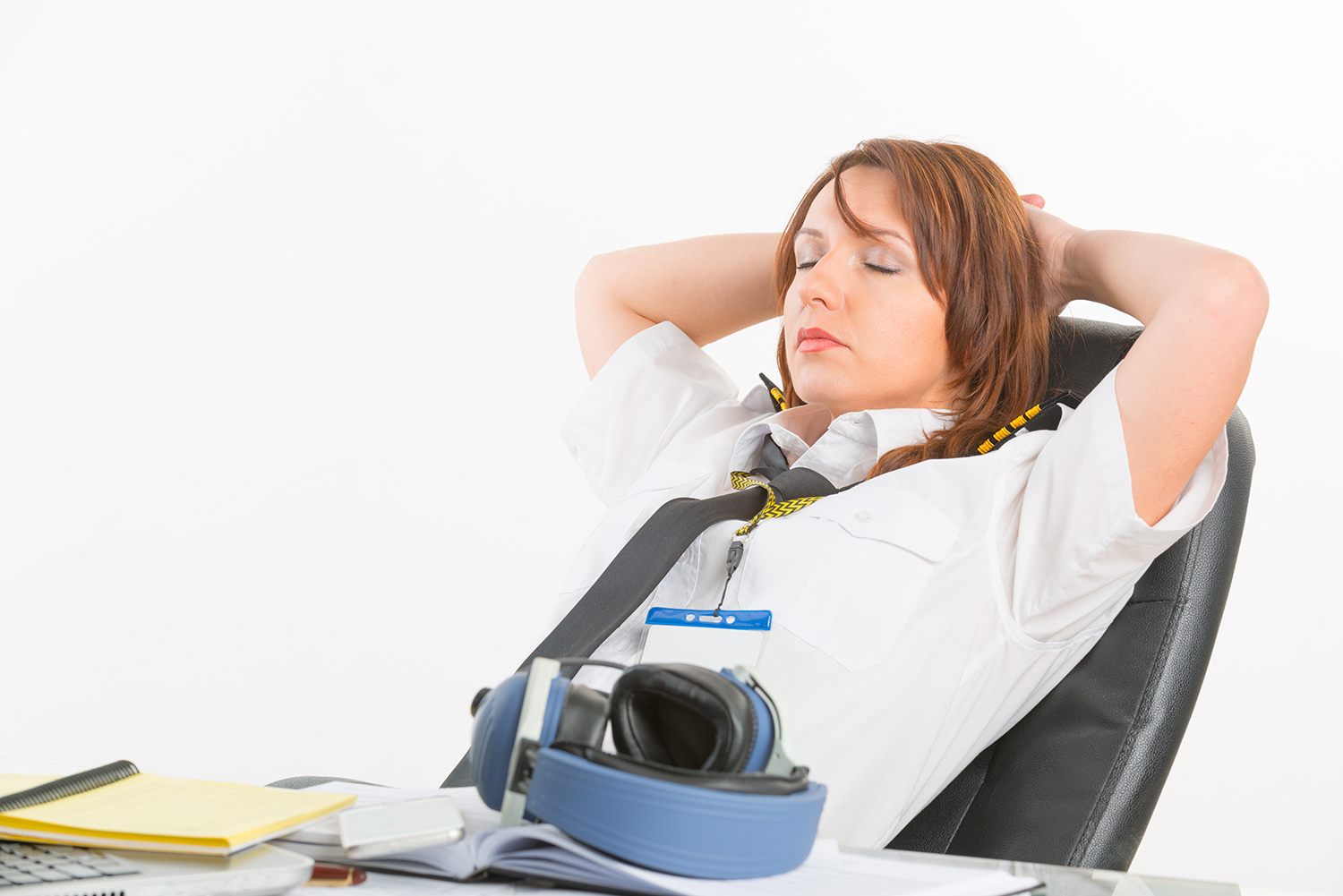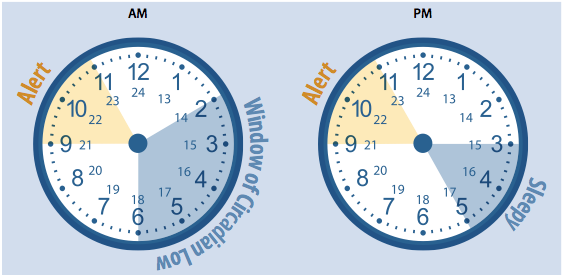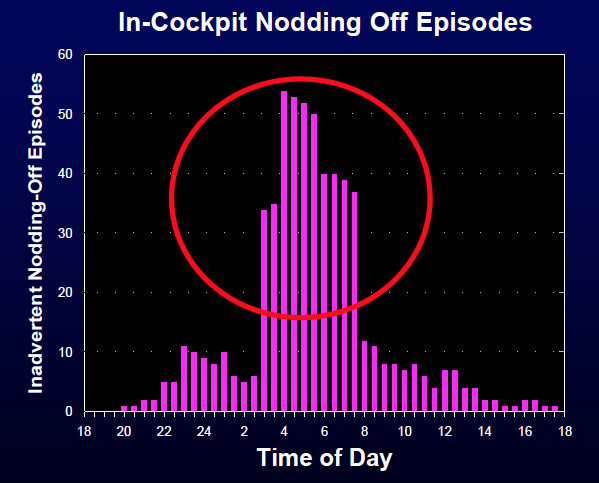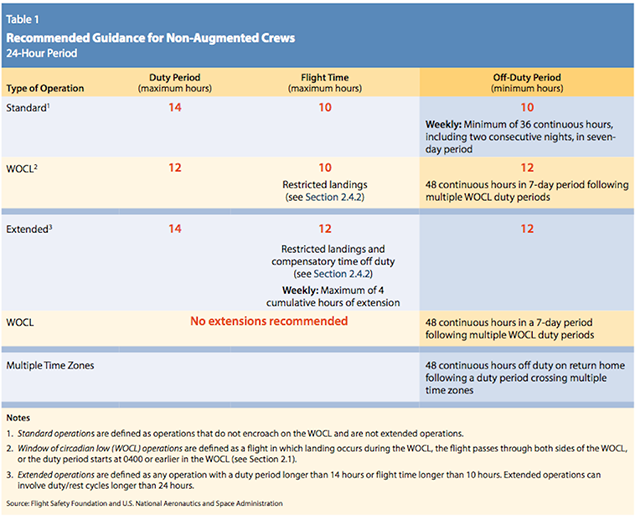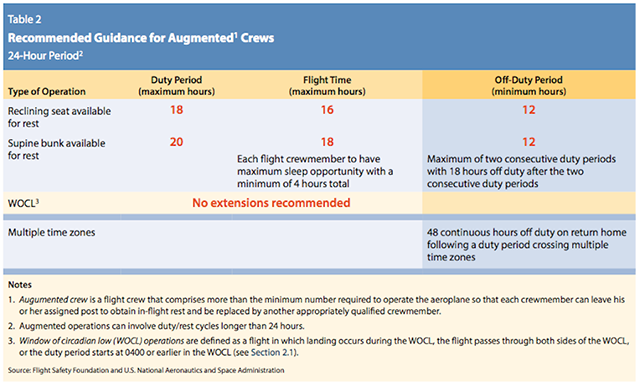I've found the short domestic hops with the day spent in the FBO in wait mode are far worse than those long haul charters. We all have individual sleep abilities and have to learn to work with what we have. Having done this for many years I think the most important piece of advice I have to offer is this: When you've been up for 12 hours, you are the last person who should be predicting your own performance 6 hours hence.
— James Albright

Updated:
2016-07-01
My record is 18 hours aloft, though some of the aircraft I've flown have logged as much as 36 hours in a single flight. Without the aid of air refueling, I've done 14+30 in a GV with four pilots on board. Having a crew rest area made a big difference.
A lot of this is related to jet lag, see Desynchronosis.

1
Definitions
- Fatigue. Fatigue refers to a physiological state in which there is a decreased capacity to perform cognitive tasks and an increased variability in performance as a function of time on task. Fatigue is also associated with tiredness, weakness, lack of energy, lethargy, depression, lack of motivation, and sleepiness.
- Sleep Inertia. Sleep inertia (also termed sleep drunkenness) refers to a period of impaired performance and reduced vigilance following awakening from the regular sleep episode or nap. This impairment may be severe, last from minutes to hours, and be accompanied by micro-sleep episodes.
- Window of Circadian Low (WOCL). Individuals living on a regular 24-hour routine with sleep at night have two periods of maximum sleepiness, also known as “WOCLs.” One occurs at night, roughly from 3 a.m. to 5 a.m., a time when physiological sleepiness is greatest and performance capabilities are lowest. The other is in the afternoon, roughly from 3 p.m. to 5 p.m.
Source: AC 120-100, ¶3.
2
Sleep-related processes
- Sleep Regulation. The drive for sleep increases over time since the last sleep period and with any cumulative deficit in sleep relative to the average 8-hour day requirement. As a consequence, the sleep drive is at its lowest point in the morning, upon awakening, and as the day progresses, the drive to sleep increases and the ability to sustain attention and engage in cognitive activities decreases. Once sleep begins, this drive gradually decreases until awakening.
- Elevated Sleep Drive. For the average person, the daily upswing in alertness produced by the circadian system tends to offset the decrease in alertness produced by depletion of the sleep regulatory process. The result is roughly constant reaction time and lapses during the first 16 hours of the day 85. After about 16 hours of continuous wakefulness, most adults begin to notice reductions in the speed of performance and in alertness levels 87. However, a prior history of insufficient sleep quantity and quality can magnify the changes in behavior and alertness.
- Desynchronization. The timing of sleep and wakefulness of most humans, under natural conditions, is consistent with the circadian control of the sleep cycle and all other circadian-controlled rhythms. However, people working in a developed society override their internal biological clock and attempt to sleep at times that are not always consistent with the biological drive to sleep. For example, when individuals travel rapidly across time zones or work the night shift, the sleep/wake cycle is out of phase with the biological rhythms controlled by the circadian clock. This can adversely affect both alertness while awake and at work, and the ability to achieve restorative sleep.
- Sleep Inertia. This sleep-related process causes a temporary degradation in performance immediately after awakening. The degradation or loss of alertness is dependent on depth of sleep at the time of awakening. The degradation dissipates, after awakening, on a time scale ranging from minutes to a few hours. Sleep inertia causes a feeling of drowsiness or lethargy and can be measured as a noticeable change in reaction time and potential for lapses in attention. The duration and severity of sleep inertia is related to the depth of sleep at the time of awakening. It tends to be greater after short sleep periods of an hour or two, when the need for sleep is not fully satisfied, or after sleep when the person is carrying a large sleep debt from prior sleep restrictions 10.
Source: AC 120-100, ¶7.
Note: For more about this, see Desynchronosis.
3
Fatigue factors
1.1 Sleep
- Sleep is a vital physiological need. Sleep is necessary to maintain alertness and performance, positive mood, and overall health and well-being. Each individual has a basic sleep requirement that sustains optimal levels of performance and physiological alertness during wakefulness. On average, an adult requires eight hours of sleep in a 24-hour period.
- It has been shown in laboratory studies that loss of as little as two hours of sleep will induce fatigue and degrade subsequent waking performance and alertness. Over successive days, sleep loss — any amount less than is required — will accrue into a cumulative sleep deficit commonly referred to as a "sleep debt." The physiological need for sleep created by sleep loss can be reversed only by sleep. Recovery from acute sleep loss takes one or two consecutive extended sleep periods. These extended sleep periods will be even longer if a person is suffering from a cumulative sleep debt. An individual who has obtained ample recovery sleep will be better prepared to perform after long hours awake or while working nonstandard schedules than a person who is operating with a sleep debt.
1.2 Recovery periods
- Recovery from acute or cumulative sleep loss is critical when a person is challenged with non-standard schedules that include extended periods of wakefulness (e.g., extended duty periods) or circadian disruption (scheduled sleep/wake periods that are misaligned with the body's circadian rhythm, described in Section 1.3). Recovery is necessary to reduce the accumulated effects of fatigue and enable an individual to perform assigned duties fully rested. Further, recovery periods should allow for recuperative sleep opportunities of an appropriate number of hours and, in some cases, an appropriate number of successive days (as noted in Section 1.1).
- Placement of recovery sleep periods is crucial and can be especially challenging when schedules include changing time zones because individuals may experience circadian misalignment. Westward travel is often associated with waking up too early in relation to the local time zone, and eastward travel is associated with delay in falling asleep in relation to the local time zone. (See Section 1.3 for further discussion.)
- Another challenge an individual may experience when planning recovery rest is adaptation to time zone shifts (jet lag), as discussed in Section 1.3. Many operational factors impact the scheduling of recovery periods, and a simple rule may not fully account for the role that individual differences play in recovery. It is known that meeting daily sleep requirements and using restorative breaks promote optimal performance and alertness.
- Frequent recovery periods reduce cumulative fatigue more effectively than less frequent ones. For example, weekly recovery periods are more likely to relieve acute fatigue than monthly recovery periods. Consequently, guidelines that ensure a minimum number of days off per week are necessary for minimizing cumulative fatigue effects over longer periods of time (e.g., month, year).
Time-of-day and circadian physiology
- Time-of-day or circadian effects are important considerations in determining 24-hour operational requirements because circadian rhythms do not adjust rapidly to change. In fact, the rhythms of many physiological functions adjust at different rates.
- There is a 24-hour biological "clock" in the human brain, as in other organisms, that regulates 24-hour patterns of body functions. This clock controls not only sleep and wakefulness alternating in parallel with the environmental light/dark cycle, but also the oscillatory nature of most physiological, psychological and behavioral functions. The wide range of body functions controlled by the clock includes body temperature, hormone secretion, digestion, physical and mental performance, mood and many others. On a 24-hour basis, these functions fluctuate in a regular pattern with a high level at one time of day and a low level at another time.
- The clock's circadian (circa meaning "around," dies meaning "day") pattern of wakefulness and sleep programs the human body for wakefulness during the day and sleep at night. This circadian system repeats this pattern on a daily basis. Certain hours of the 24-hour cycle — that is, roughly 0200 to 0600 (for individuals adapted to a usual day-wake/night-sleep schedule), called the window of circadian low (WOCL) — are identified as a time when the body is programmed to sleep, and during which alertness and performance are degraded. There is a second, less pronounced, period of reduced alertness between 1500 and 1700. The body is also programmed for two periods of enhanced alertness and performance, and these periods are estimated to occur roughly between 0900 and 1100 and again between 2100 and 2300.
- Non-standard schedules interrupt daily wake and sleep patterns, resulting in internal circadian disruption. For example, an individual working during the night is maintaining wakefulness in direct opposition to physiological programming to be asleep. Physiological, psychological and behavior al functions are set by the circadian system to a low status during the WOCL and a person cannot compensate by being awake and active. Conversely, the same individual sleeping during the day is in direct opposition to physiological programming to be awake. The circadian system provides a high level of functioning during the day that counteracts the drive to sleep.
- Circadian disruption also occurs with jet lag. When the biological clock is not aligned with the external environment's time cues, desynchronization occurs both in relation to the external environment and among the various internal physiological functions. Such circadian disruptions can lead to acute sleep loss, sleep debt, decrements in performance and alertness, and various health problems (e.g., gastrointestinal).
- Scientists agree there is no simple equation to determine the rate of circadian adjustment in any one individual. Numerous factors play a role, such as number of time zones crossed, direction of travel, amount and timing of light exposure, morning/evening types, and long sleepers vs. short sleepers. While one study in the 1970s on non-pilot volunteers suggests that when adjusting to eastbound travel, circadian rhythms adjust at a rate of 1.0 hour per day and when traveling westbound, the adjustment rate is 1.5 hours per day, this has not been confirmed with additional scientific study.
1.4 Continuous waking hours
- Extended wakefulness and prolonged periods of continuous performance or vigilance on a task will result in sleepiness and fatigue. Across duty periods, these effects can accumulate further. One way to minimize the accumulation of these effects is to limit the length of a duty period (i.e., the continuous hours of wakefulness during operations). Acute effects can be addressed through daily duty limits, and cumulative effects can be minimized by weekly limits.
- More scientific evidence is available to support guidelines for acute limits than for determining specific cumulative limits. Nevertheless, cumulative limits (weekly and beyond) remain an accepted operational approach for minimizing accumulation of fatigue effects.
1.5 Individual differences
- There are considerable individual differences in the magnitude of fatigue effects on performance, physiological alertness and subjective reports of fatigue. These differences extend to the effects of sleep loss, night work, required sleep and recovery time for an individual.
- Individuals vary from one another in sleep requirement, overall health, age and other factors. Individuals' fatigue level can also vary from day to day based on their participation in activities that contribute to fatigue while on duty and prior to a duty period. In this regard, long-duration commutes immediately before a duty period are of concern.
- Scientists agree that increased workload amplifies the performance degradation produced by extended hours of wakefulness and adverse circadian phase (that is, being awake during the WOCL). And individuals respond differently to the effects of workload. In aviation, workload factors can include the number of flight segments, time on task, airport characteristics, weather conditions, aircraft capabilities and other environmental conditions.
Source: Duty/Rest Guidelines for Business Aviation, §1.0
4
Sources of pilot fatigue
Both long-haul and short-haul pilots commonly associate fatigue with scheduling issues
- Night flights (operating at circadian low point)
- Multiple time-zone crossings (jet lag)
- Early wake ups (truncated sleep)
- Time pressure (increased workload)
- Multiple flight legs (extended work periods)
- Consecutive duty periods without sufficient recovery time (chronic sleep loss)
Source: Caldwell, pg. 6
5
Symptoms of pilot fatigue
- Accuracy and timing degrade
- Lower standards of performance become acceptable
- Attentional resources are difficult to divide
- A tendency toward preservation develops
- The ability to integrate information is lost
- Everything becomes more difficult to perform
- Social interactions decline
- The ability to logically reason is impaired
- Attention wanes
- Attitude and mood deteriorates
- Involuntary lapses into sleep begin to occur
Source: Caldwell, pg. 9
6
Effects of pilot fatigue
- A study of night flights undertaken in the 1980’s revealed numerous instances of nodding off in the cockpit
- In the early morning hours, the frequency of such lapses increased tenfold
- Note than many of these occur well after sunrise!
- Standardized laboratory tests show decrements in pilots’ attention, reaction time, and accuracy
- Fatigue-induced mood changes compromise crew resource management
- Flight simulation and in-flight studies show deteriorations in fundamental flight skills
- And the group effects fail to highlight the full extent of impairments experienced by some pilots
Source: Caldwell, pp 16, 18
7
Examples of fatigue-related mishaps
1993: American International Flight 808
"...probable cause of this accident was the impaired judgment, decision-making, and flying abilities of the captain and flight crew due to the effects of fatigue."
See: American International Airways 808.
1997: Korean Air Flight 801
"...probable cause of this accident was the captain’s failure to adequately brief and execute the non-precision approach and the first officer’s and flight engineer’s failure to effectively monitor and cross-check the approach. Contributing to these failures were the captain’s fatigue."
See: Korean Air 801.
1999: American Airlines Flight 1420
"...probable causes of this accident were the flight crew’s failure to discontinue the approach…and failure to ensure that the spoilers had extended after touchdown. Contributing to the accident was the flight crew’s impaired performance resulting from fatigue..."
See: American Airlines 1420.
FedEx Flight 1478
"...probable cause of the accident was the captain’s and first officer’s failure to establish and maintain a proper glide path during the night visual approach to landing. Contributing to the accident was a combination of the captain’s and first officer’s fatigue..."
See: Federal Express 1478.
8
Fatigue mitigation
Crew Rest Facilities
- The effects of continuous hours of wakefulness on alertness and performance can be minimized with the use of efficient in-flight rostering, which helps to ensure that at least one flight crew member is always rested.
- Scheduling bunk sleep periods that minimize the number of hours of extended wakefulness for the landing crew.
- Scheduling flight crew to perform who just had a recent bunk sleep opportunity and have an increased chance of being well-rested during critical phases of flight.
- Crewmembers have indicated that environmental factors in the bunk facilities influence the quality of in-flight rest periods. A NASA survey revealed that the most common factors that conflicted with quality bunk sleep were ambient temperature, noise from the galley and elsewhere, and background lighting.
- Finally, the duration of in-flight rest breaks (sleep opportunities) should be limited to no longer than about 6 hours. Studies have shown that even when given longer than 6 hours to sleep in the bunk, relatively few crewmembers can take advantage of that additional time.
Source: AC 120-100, ¶11.c.
No certificate holder may assign any pilot to a crew of three or four pilots, unless that assignment provides —
(5) Adequate sleeping facilities on the aircraft for the relief pilot;
Source: 14 CFR 135, §135.269(b)
Of course that begs the question, what are "adequate" sleeping facilities? Back in my long haul charter GV days, we did this a lot and got a ruling from the FAA. The answer is in AC 121-31. We got our GV modified so that the front cabin could be isolated from the rest of the airplane with a switch the guaranteed lights and sounds from the cabin entertainment system could not intrude and we were approved under this AC.
- For flight crew sleeping quarters, adequate volume should be provided for sleeping. The recommended sleeping space volume per individual is 1.0m3 (35 feet3).
- The following are acceptable criteria for sleeping surfaces: Dimensions for each sleeping surface of 1.98 x 0.76 m (78 x 30 inches). The sleeping surfaces should be designed so that they are as level as practicable during cruise flight. Suitable means should be provided to ensure occupant privacy for each sleeping surface area, e.g., curtains in an over-and-under arrangement or a divider curtain in a side-by-side arrangement.
- The flight crew rest facility or flight crew sleeping quarters should be in a location where intrusive noise, odors, and vibration have minimum effect on sleep.
Source: AC 121-31 ¶5.a.
Cockpit Napping
Sleep is the only way to reverse sleepiness. Therefore, at times when some amount of sleep is possible but limited, napping is the most effective physiological strategy for restoring alertness levels. Naps have shown to be beneficial for restoring both performance and alertness levels, especially during long periods of wakefulness 4, 5, 35, 60, 71, 72, 89, 91. Even short naps of 25-30 minutes can have beneficial effects. Controlled studies have shown that a nap can yield significant improvements in subsequent pilot alertness and vigilance performance compared to similar pilots who did not receive the nap so methods that augment crews to permit napping outside the cockpit is a viable fatigue countermeasure under current FAA rules. The FAA authorizes in-flight naps for flight crew if there is an augmented complement so that two pilots are on the flight deck while the augmented crewmembers are resting. Although a number of foreign air carriers authorized in-seat cockpit naps during flight, the FAA does not authorize such in-seat cockpit naps.
Source: AC 120-100, ¶11.b.
Activity Breaks
Short breaks can serve to increase alertness by reducing the monotony of a highly automated cockpit environment through conscious disengagement with the flying task and, possibly, by allowing mild physical activity, depending on the type of break and the behaviors allowed during the break. Although not as effective as some other countermeasures, anecdotal reports from pilots indicate that many take brief, out-of-the-seat breaks as a fatigue countermeasure.
Source: AC 120-100, ¶11.d.
Caffeine
Caffeine can be an effective countermeasure in improving alertness and performance levels 8, 88, 93. Caffeine takes 15-30 minutes to enter the bloodstream after consumption, and thus alertness effects do not occur immediately. However, its effects can persist up to 5 hours after ingestion.
Source: AC 120-100, ¶11.f.
Recovery Sleep
- Small reductions in sleep during a single trip may not cause serious changes in alertness and performance; however, if these small reductions are not made up after the trip prior to another trip, then the potential for serious accumulated sleep debt can occur. Studies have shown that an accumulation of only 1 hour of sleep loss per day over a week can have measurable effects on reaction time that may take several days to dissipate after the person returns to a normal sleep schedule.
- Recent studies have also shown that rapid recovery from accumulated sleep debt requires that the person take deliberate steps to sleep more than the usual nominal 8 hours per day. It may take the average person several days of 9 hours of sleep or more to recover from a serious sleep debt. Hence, train staff to use recovery periods to sleep more than their usual amount to prevent accumulated sleep debt across an extended work or duty schedule.
Source: AC 120-100, ¶9.c.
9
Duty/rest limit guidelines
Under 14 CFR 91 duty and rest times are at the discretion of the operator, but if there was an industry standard or "best practice," the Flight Safety Foundation recommendation comes pretty close . . .
References
(Source material)
14 CFR 135, Title 14: Aeronautics and Space, Operating Requirements: Commuter and On Demand Operations and Rules Governing Persons on Board Such Aircraft, Federal Aviation Administration, Department of Transportation
Advisory Circular 120-100, Basics of Aviation Fatigue, 06/07/10, U.S. Department of Transportation
Advisory Circular 121-31, Flight crew Sleeping Quarters and Rest Facilities, 9/30/94 U.S. Department of Transportation
Caldwell, John A., Sleep and Psychomotor Performance during Commercial Ultra-Long Range Flights, FAA Fatigue Management Symposium, Vienna, VA, June 17-19, 2008
Flight Safety Foundation, Duty/Rest Guidelines for Business Aviation, April 2014
George, Fred, Fatigue Risk Management, Business & Commercial Aviation, February 2011
Herguth, Robert, BGA: Pilot fatigue, error raised in 'overrun' on O'Hare runway, Better Government Association, 06/04/2016
NTSB Aircraft Accident Report, AAR-94/04, Uncontrolled Collision with Terrain, American International Airways Flight 808, Douglas DC-8-61, N814CK, U.S. Naval Air Station, Guantanamo Bay, Cuba, August 18, 1993
NTSB Aircraft Accident Report, AAR-00/01, Korean Air Flight 801, Boeing 747-300, HL7468, Controlled Flight Into Terrain, Nimitz Hill, Guam, August 6, 1997
NTSB Aircraft Accident Report, AAR-01/02, Runway Overrun During Landing, American Airlines Flight 1420, McDonnell Douglas MD-82, N215AA, Little Rock, Arkansas, June 1, 1999
NTSB Aircraft Accident Report, AAR-04/02, Collision With Trees on Final Approach, Federal Express Flight 1478, Boeing 727-232, N497FE, Tallahassee, Florida, July 26, 2002
